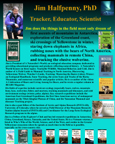Yellowstone Bears in the Wild reveals the secrets of Yellowstone's bears
Grizzly bears love to play, sleep, and eat small bugs, according to a new book about the bears of Yellowstone National Park.
Based on the park's latest scientific research, "Yellowstone Bears in the Wild" by Dr. Jim Halfpenny provides an intriguing portrait of Yellowstone's grizzly and black bears. From hibernation to hyperphagia, the book describes everything about the bears: how they live and what they eat, where they go and what they do, how they raise their cubs and how they interact with wolves and other animals, including people.
Like he did in his highly acclaimed "Yellowstone Wolves in the Wild," Halfpenny brings the science to life with remarkable personal stories by bear biologists and bear watchers. In one story about curiosity and play, Kerry Gunther, the park's bear management biologist and author of the book's foreword, tells how a grizzly bear came out of the forest to play with a beach ball it had spotted in Gunther's back yard. Gunther also provides a startling series of photographs of an adult grizzly bear climbing a tree, proving false the old adage that grizzlies can't climb trees.
Most of the photographs are by Michael H. Francis, a professional wildlife photographer. Some of his images are quite unusual, such as a series showing a grizzly bear lying on its back and juggling a large bone with its upraised feet, and a black bear digging into a tree trunk so rapidly that wood chips fly as if from a chain saw. In a testament to the greater visibility of bears in Yellowstone today, all of the photos show wild bears in the park; there are no photos of captive bears.
In recent years thousands of Yellowstone visitors came to know female grizzly bear number 264. The book has a chapter on her life and she is featured in several photos. In a clever innovation that makes the book a memorable keepsake, 264's actual footprints are imprinted on the book's front and back covers.
The book provides fascinating new information on many subjects, including bear sizes, predation, scavenging, hibernation, and eating ants, moths, worms, and other unusual foods. It explains "bear art," a bear's "personal space," and bear "thinking." The book also examines how bears are reacting to critical ecological changes taking place in Yellowstone, such as the precipitous decline of cutthroat trout and whitebark pine trees.
From claws and cubs to foods and fur, "Yellowstone Bears in the Wild" vividly presents the lives of grizzly and black bears in the world's first national park. Anyone interested in bears or in Yellowstone will enjoy this remarkably entertaining and educational book.
|

